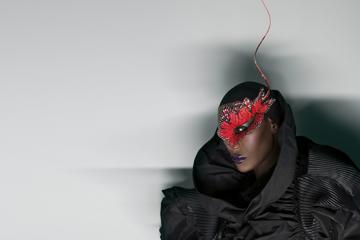Live Review: Matthew Herbert
Herbert and his group receive a standing ovation for this show, which is truly unique and quite bizarre.

A man walks out on stage, picks up some hay from a hay bale and rustles it in front of the microphone. A second man comes on and breathes into the microphone. One by one the performers enter and offer up different sounds until there are five people on the stage. They all put on white lab-coats and sit around what looks like a pigpen. Yann Seznec, creator of the StyHarp, turns to reveal his back to the audience. It reads “SEP” (September abbreviated). Throughout the performance, he changes into lab-coats emblazoned with different months of the year, which represents a month in the pig's life. In August, he jumps around in the pigpen. In September, the music is chaotic. In October, a melody is made from snorts and oinks, and the music becomes slow and dreamlike with brass and horns. Each pull of the StyHarp string makes a different snorting sound and it makes an amusing, almost cartoon-like melody that makes some audience members giggle.
But the fun, playful sounds are over in December, with sounds of a chainsaw and an ear-splittingly loud screech, which causes members of the audience to block their ears. A second member joins the pigpen, then a third, then Matthew Herbert, then the last remaining performer. They all pull on the strings in different directions, creating a noisy melting pot of sounds. The whirring sound of a propeller buzzes throughout the room. Seznec takes off his lab-coat to reveal a fire engine red jacket. It's easily identifiable as representing blood and the pig's slaughter when the sound of blood dripping fills the room with haunting echoes.
Jesse Gerner, head chef at Melbourne's Ayslebury Bar & Restaurant, appears at the back of the stage and holds up two large knives, rubbing them together in an exaggerated fashion. A group member cuts into a large, white bone with a saw and moves it back and forth, grinding and grating the audience's ears and tingling their spines. This sound becomes a sample for the next song and Herbert adds a beat, tweaking and twisting knobs to take the music off in a new direction.
The smell of cooked pork starts wafting through the room with the assistance of a fan. There's another loud buzz that gets higher and higher in pitch. The sound of pork sizzling gets louder and again Herbert transforms this into a loop for another new song, this one down-tempo and cruisey. The smell becomes more pungent, filling the room and everyone's noses within. There's a lot to watch at the one time – Gerner adding spices here and garnishing there; Herbert intent on twisting knobs, pushing buttons and keys; the drummer beating his drums made of pigskin; others pulling the strings of the StyHarp in different directions.
Don't miss a beat with our FREE daily newsletter
Gerner lights a candle at the table and the music comes to an end. Herbert sings a heartwarming, melancholic song at the piano, a kind of prayer or grace, with lyrics such as, “A simple love is all we need/Enough to multiply/Dignify each day, and so to rest upon my head/Occupy my thoughts instead,” while the other ensemble members stand around the table, heads bowed and hands clasped, with the cooked pork before them. The last sound the audience hears is chewing, chatter, cutlery jangling and slurps.
Herbert and his group receive a standing ovation for this show, which is truly unique and quite bizarre. The cooked pork dishes remain untouched on the table and the question as to whether they will be eaten is left unanswered. It is a fitting end to a musical journey that provokes questions about slaughtering and eating animals, the process an animal goes through from farm to dinner table, and remembering the life of an animal through music.







